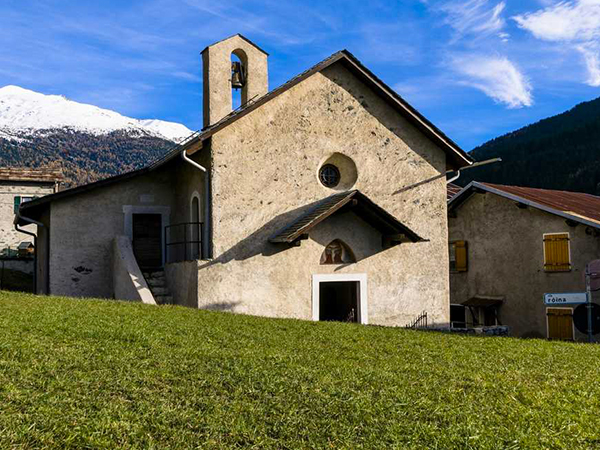Church of the Santissima Trinità
CONTACT: +39 0342 945030 (Mrs. Albina)
DIRECTIONS: hamlet of Teregua. Leave Bormio in the direction of Madonna dei Monti
DESCRIPTION:
The sixteenth century Church of the Santissima Trinità, hidden amongst the houses of a small hamlet in the municipality of Valfurva, is identified by its bell gable, a unique feature typical of small country churches. The church’s gabled façade is embellished with an oculus, as well as a fresco depicting the Trinity in the lunette over the entrance portal. Its dedication to the Holy Trinity, a cultured and decidedly less popular choice than the intercessory saints and the Virgin, is an indication of the crisis that Catholicism was experiencing due to the Lutheran Revolt (1517), as well as the climate that anticipated the Council of Trent (1545). The church is a small building with a single room. Along with a Tyrolean-school altarpiece, it has a coeval fresco cycle in the apse painted in 1546 by Vincenzo De Barberis, a well-known artist from Brescia in the circle of Bernardino Luini, who worked in Valtellina for thirty years. The painting by Vincenzo De Barberis in the apse of the church in Teregua is dominated by the iconography of the Trinity and the four Evangelists, but it also pays tribute to popular devotion, with depictions of the virgin martyrs St. Agatha, St. Agnes, St. Lucy, St. Barbara and St. Catherine appearing near St. George, St. Anthony, St. Roch and St. Nicolas. The wooden altarpiece (first half of the sixteenth century) was inspired by German-style winged altarpieces and combines the subject of the Trinity with the Madonna Lactans and the soldier martyrs Gervasius and Protasius. In 1635, during the Thirty Years War, the church was burned by French troops commanded by the Duke of Rohan, causing damage to the frescoes and the loss of the bell. Three years later, the bell was replaced with a new bronze work produced by the well-known founder Nicolas Garnier from Lorraine. During this period (1644), a new sacristy was built over the previous one. It included a storage room for Monte di Pietà, an organization that helped orphans and widows who were victims of the plague. In 1869, the church survived another fire that erupted in nearby houses. During World War I, when the front ran across the ridges above the village of Teregua, the church was used to shelter troops. In order to protect the paintings, the choir was closed off with canvas to limit the extent of damage caused by smoke from the stoves that provided heat for the soldiers during the winter. Afterwards, the frescoes and the altarpiece were repainted, which unfortunately changed the original colours. Dampness caused by the widening of the adjacent street put the entire decorative scheme at risk.
INTERESTING FACT:
To the surprise of many, during the summer of 2004 the Church of the Santissima Trinità in Teregua was voted a “Luogo del Cuore” (Favourite Place) by 3142 people who demanded its rescue. The small church came in fourth place in the national ranking of the second FAI (Fund for the Italian Environment) census. On 25 October 2005, the Teregua Association was formed with the aim of completely restoring the monument to return this precious religious, historical and artistic heritage to the community. A book entitled La Chiesa della Santissima Trinità di Teregua in Valfurva – Storia, arte devozione, restauro (The Church of the Santissima Trinità in Teregua in Valfurva: History, Art, Devotion and Restoration), published by the Teregua Association, contains a series of essays on the church.




